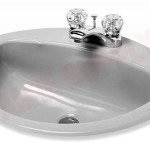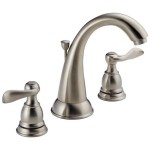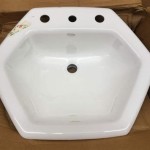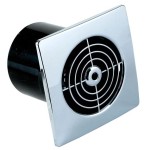Ceramic Bathroom Sinks: A Comprehensive Overview
Ceramic bathroom sinks represent a ubiquitous and enduring choice for both residential and commercial spaces. Their popularity stems from a confluence of factors, including aesthetic versatility, durability, ease of maintenance, and a wide range of design options that cater to diverse stylistic preferences. This article provides a comprehensive overview of ceramic bathroom sinks, exploring their composition, manufacturing process, various types, advantages, disadvantages, and key considerations for selection and maintenance.
The term "ceramic" encompasses a broad category of materials that are non-metallic, inorganic solids. In the context of bathroom sinks, the most commonly used ceramic materials are porcelain, vitreous china, and fireclay. Each material possesses distinct characteristics that influence the sink’s final appearance, performance, and cost.
Porcelain is a type of ceramic known for its hardness, durability, and resistance to staining. It is manufactured by firing a clay-based mixture at high temperatures, resulting in a dense and non-porous material. Porcelain sinks are available in a variety of finishes, from matte to high-gloss, and can be molded into intricate shapes and designs. Their resilience makes them a popular choice for high-traffic bathrooms.
Vitreous china is a type of porcelain that has been glazed with a vitreous enamel to create a smooth, glossy, and highly durable surface. This glazing process renders the sink virtually non-porous, making it exceptionally resistant to stains, scratches, and bacteria. Vitreous china sinks are widely recognized for their ease of cleaning and their ability to maintain a pristine appearance over time. The smoothness also makes them very hygienic.
Fireclay is a more robust and heavier type of ceramic material. It is created by firing clay at extremely high temperatures, resulting in a sink that is exceptionally strong and resistant to warping or cracking. Fireclay sinks often have a thicker profile and a more handcrafted appearance compared to porcelain or vitreous china sinks. They are particularly well-suited for farmhouse-style bathrooms or applications where a substantial and durable sink is desired.
The manufacturing process of ceramic bathroom sinks typically involves several distinct stages. First, a clay-based mixture is prepared, often incorporating additional materials such as feldspar, silica, and kaolin. The specific composition of the mixture will vary depending on the type of ceramic being produced. Next, the mixture is cast into a mold that defines the desired shape of the sink. Once the clay has partially dried, it is removed from the mold and carefully inspected for any imperfections. If necessary, any rough edges or blemishes are smoothed out.
The sink is then fired in a kiln at high temperatures. This process vitrifies the clay, transforming it into a hard, durable, and water-resistant material. The firing temperature and duration will depend on the type of ceramic being produced. After firing, the sink is allowed to cool gradually to prevent cracking. In the case of vitreous china sinks, a vitreous enamel glaze is applied to the surface and the sink is fired again to fuse the glaze to the ceramic body. This final firing creates the smooth, glossy, and non-porous surface that is characteristic of vitreous china sinks.
Key Types of Ceramic Bathroom Sinks
Ceramic bathroom sinks are available in a wide array of styles and configurations to suit diverse design preferences and spatial requirements. The following are some of the most common types:
Undermount Sinks: Undermount sinks are installed beneath the countertop, creating a seamless and streamlined appearance. The edges of the sink are concealed beneath the countertop material, resulting in a clean and modern aesthetic. Undermount sinks are easy to clean as there is no rim to collect debris. They also maximize countertop space.
Top-Mount (Drop-In) Sinks: Top-mount sinks, also known as drop-in sinks, are installed from above the countertop. A hole is cut in the countertop, and the sink is dropped into the hole. The rim of the sink rests on the countertop, providing a visible edge. Top-mount sinks are relatively easy to install and are a cost-effective option.
Vessel Sinks: Vessel sinks are designed to sit on top of the countertop, resembling a decorative bowl. They are available in a wide range of shapes, sizes, and styles, making them a popular choice for adding a touch of visual interest to the bathroom. Vessel sinks require a taller faucet to accommodate their height.
Pedestal Sinks: Pedestal sinks consist of a sink basin mounted on a freestanding pedestal base. They are a classic and space-saving option, particularly well-suited for smaller bathrooms. Pedestal sinks typically provide minimal storage space.
Wall-Mounted Sinks: Wall-mounted sinks are attached directly to the wall, without the need for a countertop or pedestal. They are an excellent choice for maximizing floor space and creating a minimalist aesthetic. Wall-mounted sinks require sturdy wall support and may conceal plumbing.
Console Sinks: Console sinks combine a sink basin with a metal or wooden frame that provides support and often incorporates storage shelves or drawers. They offer a balance of style, functionality, and storage capacity.
Advantages of Ceramic Bathroom Sinks
Ceramic bathroom sinks offer several compelling advantages that contribute to their widespread popularity:
Durability: Ceramic materials such as porcelain, vitreous china, and fireclay are exceptionally durable and resistant to chipping, cracking, and scratching. Properly installed and maintained ceramic sinks can withstand daily use for many years.
Ease of Cleaning: The smooth, non-porous surface of ceramic sinks, particularly those with a vitreous china glaze, makes them remarkably easy to clean. Most spills and stains can be easily wiped away with a damp cloth and mild detergent.
Stain Resistance: Ceramic sinks are highly resistant to staining from common household substances such as soap, toothpaste, and cosmetics. This ensures that the sink maintains its pristine appearance over time.
Variety of Styles: Ceramic sinks are available in a vast array of styles, shapes, sizes, and colors, allowing homeowners to find the perfect sink to complement their bathroom décor. From traditional to contemporary designs, there is a ceramic sink to suit every taste.
Affordability: Ceramic sinks are generally more affordable compared to sinks made from other materials such as stone, copper, or glass. This makes them a budget-friendly option for bathroom renovations or new construction.
Hygienic Properties: The non-porous surface of ceramic sinks inhibits the growth of bacteria and mildew, making them a hygienic choice for bathrooms.
Disadvantages of Ceramic Bathroom Sinks
Despite their numerous advantages, ceramic bathroom sinks also have some potential drawbacks to consider:
Weight: Ceramic sinks, especially those made from fireclay, can be quite heavy, which may require additional support during installation.
Susceptibility to Impact Damage: While ceramic sinks are generally durable, they can be susceptible to chipping or cracking if subjected to a significant impact. Dropping heavy objects into the sink can cause damage.
Potential for Staining (Unglazed Surfaces): While glazed ceramic sinks are highly stain-resistant, unglazed ceramic surfaces may be more prone to staining. It is essential to choose a sink with a high-quality glaze for optimal stain resistance.
Limited Color Options (in some cases): While ceramic sinks are available in a variety of colors, some less common or specialty colors may be more difficult to find and may come with a higher price tag.
Repair Complexity: Repairing chips or cracks in a ceramic sink can be challenging and may require professional assistance. In some cases, it may be more cost-effective to replace the sink entirely.
Installation Considerations: Depending on the type of sink and the existing plumbing configuration, installation can be more or less complex. Professional installation is often recommended to ensure proper functionality and prevent leaks.
When selecting a ceramic bathroom sink, several key factors should be taken into consideration. The first is the overall style and aesthetic of the bathroom. The sink should complement the existing décor and contribute to the desired look and feel of the space. The size of the bathroom and the available countertop space are also important considerations. In smaller bathrooms, a pedestal sink or wall-mounted sink may be the best option for maximizing space. In larger bathrooms, there may be more flexibility in choosing a larger sink or a double sink configuration.
The intended use of the sink should also be taken into account. If the sink will be used primarily for washing hands, a smaller sink may suffice. However, if the sink will be used for more demanding tasks, such as washing clothes or filling buckets, a larger and more durable sink may be necessary. The budget is another important consideration. Ceramic sinks are available in a wide range of price points, so it is important to set a budget and choose a sink that fits within that budget.
Finally, it is essential to consider the quality of the ceramic material and the glaze. Look for sinks made from high-quality porcelain, vitreous china, or fireclay, and ensure that the glaze is smooth, glossy, and free from imperfections. A high-quality sink will not only look better but will also be more durable and easier to maintain. Proper maintenance of a ceramic bathroom sink involves regular cleaning with a non-abrasive cleaner and a soft cloth. Avoid using harsh chemicals or abrasive scrubbers, as these can damage the glaze and dull the surface. Wipe up spills promptly to prevent staining, and avoid dropping heavy objects into the sink. With proper care and maintenance, a ceramic bathroom sink can provide years of reliable performance and add lasting beauty to any bathroom.

The Beauty And Durability Of Ceramic Bathroom Sinks A Comprehensive Guide

Ceramic Unique W B Wash Basin Bathroom Vessel Sink Above

Cerastyle 064200 U Bathroom Sink Mona Nameek S

Round Bathroom Countertop Basin Hand Painted Ceramic Sink Bvm Home

Tecla Co01011 By Nameek S Condal Rectangular White Ceramic Wall Mounted Or Drop In Sink Thebath

Casainc White Ceramic Oval Bathroom Basin Vessel Sink Hywy 7146 The Home Depot

Kraus Elavo 16 3 4 In Oval Porcelain Ceramic Undermount Bathroom Sink White With Overflow Drain Kcu 273 The Home Depot

Hotel Bathroom Basin Art Balcony Washbasin Hand Washing Sinks Bowl Antique Painted Sink Ceramic

Scarabeo 5133 By Nameek S Teorema 2 Rectangular White Ceramic Trough Drop In Sink Thebath

Buy Round Vessel 14 Inch Ceramic Bathroom Sink Kraus
Related Posts







